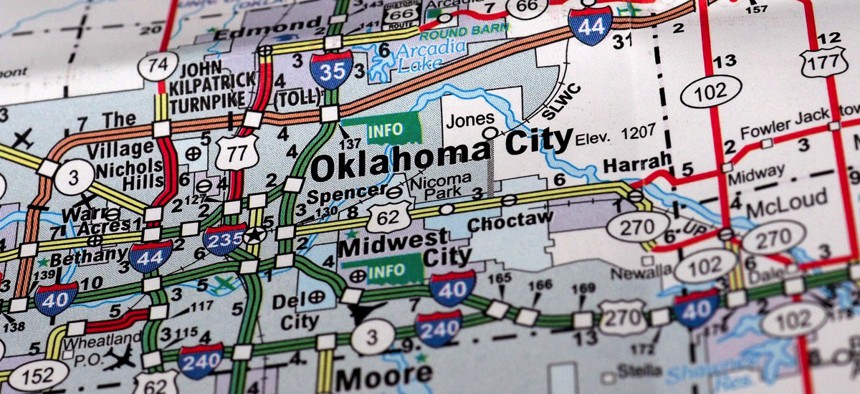10 Ideas for Mayors Looking to Manage the Transition to Autonomous Vehicles

AVs don’t have to spell the death of walkable cities.
WASHINGTON — Oklahoma City had the unwanted distinction of being one of the least walkable cities in the U.S. when Mayor Mick Cornett took office in 2004. Since then the city has rebuilt 40 blocks of streets in its downtown core to be a more pedestrian-friendly environment.
Urban designer Jeff Speck, author of “Walkable City,” was brought in to help Oklahoma City rethink its downtown area by rightsizing streets, eliminating unnecessary lanes, introducing traffic calming, adding new trees and planning a robust cycling network.
A decade later, the work in downtown Oklahoma City is still the project Speck is most proud of, and Cornett expressed gratitude while introducing him Thursday morning at the U.S. Conference of Mayors annual winter meeting in the nation’s capital.
“In Oklahoma City, where I grew up, we drove, and that just seemed to be the way it is,” Cornett said. “And I realized, upon examination and in looking at the obesity rate in my city, that the built environment was a significant problem that had helped us lead to this kind of unhealthy culture, and the built environment needed to be change.”
Just as city hall leaders around the nation are prioritizing the creation of more walkable communities, they also need to think ahead to prepare for the mass introduction of autonomous vehicles to their streets and the impacts they’ll have on transportation.
Speck had 10 observations for the mayors that he said could help with them plan for the autonomous vehicle transition.
1) Be afraid. Increased reliance on cars has doubled the amount of income drivers spend on them without getting them around congested cities any faster than the horse and buggy, Speck said. Cars have also expedited climate change and its negative effects like rising sea levels, require infrastructure that’s an eyesore, limit exercise, and are involved in about 38,000 fatal crashes a year.
“The technology won, and it will again,” Speck said, meaning that AVs will come with their own set of drawbacks, saving hundreds of thousands of lives to the detriment of the organ donation industry, for instance.
2) Be realistic. “Major change won’t happen within a decade or several,” Speck said.
The real benefits of AVs only kick in after full autonomy, he explained, which would require a more socialistic system of government helping the drivers put out of work afford purchasing them.
Achieving a fleet of AVs capable of “swarming” would mean mandating them on the roads, and that limits freedom of choice. But if you let the sports car enthusiast keep driving his supercar, you may not save as many lives with AVs as you thought, Speck pointed out.
3) Decide how much traffic you want. AVs could cut the cost of driving as much as 80 percent, Speck said, but that would increase demand to 60 percent more trips on city streets already at capacity.
Induced demand isn’t a problem with swarming, but if that can’t be achieved regulation is necessary because less people will be using public transit. And they won’t mind sitting in traffic in their AVs either, when they can get work done or stream videos.
That calls for regulation with not laws, but lanes. Just be mindful of sidewalk space.
“The right solution will be to make streets what you want them to be,” Speck said.
4) Plan for more sprawl pressure. Highways, mortgage programs, local subsidies and racism—but mostly highways—account for sprawl, Speck said.
Sprawl increases stress on infrastructure, and while AVs might not be as much of a burden as universal car ownership, mayors will be the ones to have to regulate their sprawl effect.
5) Understand transit geometry. In an ideal world, everyone driving would rideshare, but most cars only have one occupant.
As a result, AVs will supplement transit but not be a solution to congestion, Speck said. There’s a reason Ford is investing in autonomous buses too.
6) Don’t rob transit. Not only are AVs not a cure-all, but they actually threaten transit investment.
Uber admits its fare pricing isn’t sustainable, Speck said, which means it’s predatory. Money taken from transit reduces overall mobility.
7) Own the streets and the data. City planners like Speck worry AV providers might offer to buy entire streets or segments and that officials will take the payout.
That inherently limits a streets uses, and “they belong to us all,” Speck said.
8) Don’t buy any urban vision that forgets urbanism. This is Speck’s favorite rule.
“Nobody willfully walks on an empty, windswept highway overpass,” Speck said.
9) Unify around set policy demands. City officials and transportation agencies must collectively determine the future of AVs while protecting transit and prohibiting empty circling trips.
10) Invest now in the current technological revolution. “What if I were to tell you that there is a transportation technology available now that outperformed AVs by almost every measure, that traveled 50 to 80 times further per calorie expended than the automobile, that required very little space, that could drive on existing infrastructure with minimal modification, that didn’t pollute, that made its users healthier, happier and skinnier?” Speck asked. “Well, ladies and gentlemen, that technology exists, and more than half of you own it already; it’s called a bicycle.”
Investing in protected bike lanes grows cycling populations in cities.
Copenhagen, Denmark, has four times as many cyclists than drivers—an attainable goal.
“Autonomous vehicles are the right answer to the wrong question. Why do we all, even MIT’s Media Lab and Google, keep asking how we can make cars better? Where has that ever gotten us?” Speck asked. “The proper question is: How can we provide the most useful mobility to the most people with the most positive outcomes for society? The answer includes cars, but it also includes trains, buses, bikes and walking—especially biking and especially walking.“
Dave Nyczepir is a News Editor at Government Executive’s Route Fifty and is based in Washington, D.C.
NEXT STORY: Mayors Hear From Bill Ford on Autonomous Vehicles and Other Emerging Technologies






